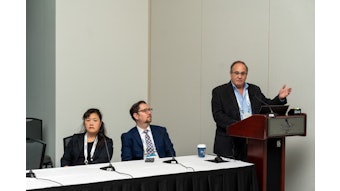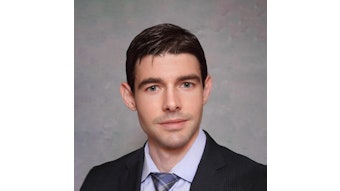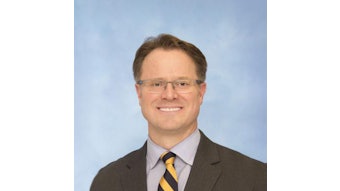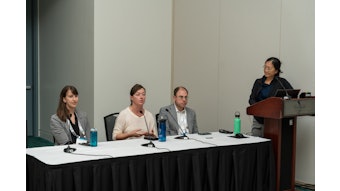Expert Consensus Statement: Managing Dysphasia in Head and Neck Cancer Patients
Consensus statement seeks to prevent and manage swallowing impairment in head and neck cancer patients.

Forty-eight finalized statements have reached consensus for the management of dysphasia in head and neck cancer patients. The final expert consensus statement (ECS) is scheduled to be released for publication early next year. A panel of four otolaryngologists discussed some of its highlights at Sunday’s “Expert Consensus Statement: Management of Dysphasia in Head and Neck Cancer Patients.” They also explored concerns and barriers for each from screening to surveillance.
Maggie A. Kuhn, MD, MAS, Associate Professor of Otolaryngology, Head and Neck Surgery at the University of California, Davis, moderated the panel, which consisted of M. Boyd Gillespie, MD, Professor and Chair of Otolaryngology, Head and Neck Surgery at the University of Tennessee, Memphis; Katherine A. Hutcheson, MD, Professor of Head and Neck Surgery at MD Anderson Cancer Center; and Gina D. Jefferson, MD, MS, Professor of Otolaryngology, Head and Neck Surgery, University of Mississippi Medical Center.
Dr. Kuhn explained the difference between ECSs and clinical practice guidelines, the process of literature review, level of evidence, methodology, and other considerations. Early steps involved systematic searches by a literature search specialist, which yielded 121 relevant results in Stage 1 and 209 in Stage 2. As a result, 48 statements met consensus, while 12 did not.
The final 48 statements fell into one of six categories: Risk Factors, Screening, Evaluation, Prevention, Intervention or Surveillance.
Risk Factors
In the category of risk, the ECS identifies three areas of increased risk for developing dysphasia from head and neck cancer treatment. These included patient factors such as age and pre-treatment nutrition, tumor factors such as recurrence and advanced T and N stage, and treatment factors such tracheostomy, chemotherapy, and radiation.
Screening
Three statements emerged in the screening section. The panel discussed “SLP consultation is optimal prior to treatment in head and neck cancer patients who are at risk for dysphasia.”
“The optimal time is actually prior to treatment because it sets a starting point,” said Dr. Jefferson. She said there are decreasing numbers in head and neck cancers due to tobacco cessation, on the one hand, but increases due to the human papillomavirus on the other. A barrier for this consensus statement, she said, is general availability of SLPs as well as transportation issues related to getting to these appointments. “It can be difficult for patients to get to all of their appointments, and especially if the SLP is in another city or across the state.”
Evaluation
In the category of Evaluation, there are nine consensus statements. The panel specifically addressed “Pre-treatment instrumental swallowing evaluation establishes baseline swallowing function and impairment in head and neck cancer patients who report symptoms of dysphasia or who are at risk of developing dysphasia during treatment.”
“There is value in determining a baseline and getting an instrumental swallowing evaluation,” said Dr. Hutcheson. Unfortunately, the perceived value of this by the provider as well as the patient provides a bit of a barrier. She said getting the evaluation as well as the specific timing of this is vitally important.
Prevention
The Prevention category yielded 11 consensus statements. The panel discussed “Radiation associated dysphasia can be reduced by contouring and avoiding swallowing organs-at-risk (SWOARS) during head and neck radiotherapy,” and “The use of intensity-modulated radiation therapy (IMRT) is associated with less xerostomia than conventional techniques, which has a positive impact on swallowing.”
In addressing the first statement, Dr. Gillespie said having a radiation specialist in the workgroup whose experience shed light on new radiation techniques was key. As for the second statement, Dr. Gillespie pointed to the importance of the development of IMRT for oncology. It can significantly reduce long-term morbidity and improve local control, he said.
Intervention
There are 18 intervention consensus statements, of which the panel explored the following three:
- Oral intake is encouraged in head and neck cancer patients judged by a dysphasia specialist to be low risk for consequences of aspiration.
- NPO status is not universally required for aspirating head and neck cancer patients.
- Pharyngoesophageal dilation is beneficial in head and neck cancer survivors who report dysphasia and have identified stenosis.
“These had high overall scores,” said Dr. Hutcheson. “Starting oral intake early is valuable and remains valuable throughout.” She said it really marries nicely with instrumental evaluation and helps in assessment of any nutritional risk.
“The evidence is pretty strong,” Dr. Gillespie agreed. “Radiation causes 5%-20% upper pharyngoesophageal stenosis. We have treatments that can help with this. Some of the radial balloon dilation has promise.”
Surveillance
Finally, of the six surveillance consensus statements, the panel addressed life-long monitoring and tracking nutrition status and health outcomes after head and neck cancer.
Dr. Jefferson said swallowing dysfunction remains a strong complaint, possibly as high as 50% of patients. Continuing to monitor the patient is important. Signs or symptoms to watch for include if patients alter their diets, increase the time it takes to eat, cough or clear their throats more and have their voices changed. She said physical findings include a decreased opening of their mouth, weight loss, and decreased quality of dentition.
Dr. Kuhn said the final manuscript will include more than 170 citations.











